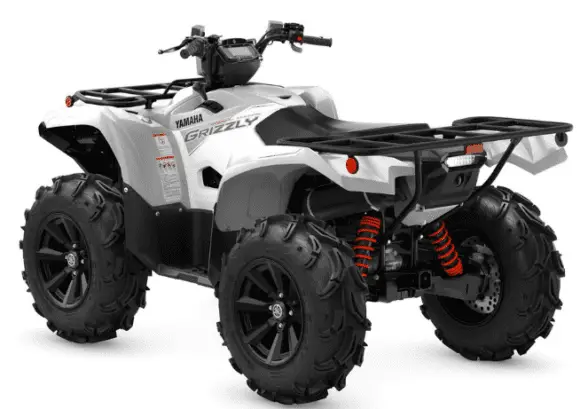The Yamaha Grizzly 700 is one of the most popular ATV models from Yamaha. Known for its powerful 700cc engine and rugged build, the Grizzly 700 is designed to handle rough terrain and heavy loads. However, like any machine, the Grizzly 700 is not without its problems.
In this blog post, we will look at some of the most common issues faced by Grizzly 700 owners, including problems with the steering, brakes, engine noise, and more.
Understanding these common faults can help you identify and fix problems before they lead to major repairs.
8 Common Yamaha Grizzly 700 Problems

1. Stability Issues
With its compact size and lightweight frame, the Grizzly 700 can feel unstable when riding over uneven terrain or turning on hills. The ATV’s narrow stance and high center of gravity make it prone to tipping over sideways or rolling when cornering sharply on inclines. Riders often complain about the quad sliding out from under them in off-camber situations.
To help with stability:
- Lower your body position by bending your knees and sitting deeper in the seat when riding on hills or uneven ground. This helps lower the center of gravity and plant more weight over the wheels.
- Slow down before entering corners and turns. Excess speed is a major factor in rollovers. Control your throttle and brakes through the turn.
- Lean your upper body into the turn, keeping your weight on the inside wheels and gripping the tank with your knees. This counterbalances the forces trying to tip you over.
- Use the differential lock button when you have limited traction. Locking the rear wheels helps prevent sideways sliding in slippery conditions.
- Install aftermarket wheel spacers to widen the stance if you regularly ride rough terrain. This mod enhances stability.
- Adjust the tire pressure. Insufficient pressure allows the sides of the tires to roll and slide more easily.
- Attach rock sliders or skid plates to lower the center of gravity slightly.
2. Engine Noise and Overheating
The single-cylinder 686cc engine in the Grizzly 700 is naturally louder and runs hotter than twin-cylinder designs. The throaty exhaust note and engine heat can make rides uncomfortable, especially on hot days or when idling.
To reduce engine noise:
- Install a quieter aftermarket muffler or exhaust silencer to dampen the decibel levels. Look for models designed specifically for the Grizzly 700.
- Add sound-dampening material like exhaust wrap to the exhaust headers and muffler. This can tame the noise coming off the engine.
- Adjust the valves to factory specifications if they are too loose. Excessive valve lash can make the engine noisy.
To prevent overheating:
- Clean the radiator frequently to remove clogged dust and debris. Use compressed air or a garden hose to blow out between the cooling fins.
- Check that the coolant level is filled to the recommended mark. Top up with the specified coolant mix if low.
- Install an aftermarket radiator fan kit to improve airflow at low speeds or when idling. This enhances the cooling capacity.
- Consider adding a radiator relocation kit to mount the radiator in a better-ventilated spot if overheating is chronic.
- Check the thermostat and replace it if the engine consistently runs hotter than the normal operating temperature.
3. Air Filter Problem
The foam air filter on the Grizzly 700 is prone to letting dust and sand particles bypass into the engine if not maintained properly, especially when riding in dry, dusty conditions. This can quickly cause excessive wear.
To prevent dirt from bypassing the filter:
- Apply a sealing grease like Yamaha foam filter oil around the edges and seams of the filter. This seals the filter and housing to block particles. Reapply after cleaning.
- Clean the air filter frequently by tapping it gently or using low-pressure air to remove dust. Avoid knocking the filter as this can damage the foam.
- Replace the filter at the intervals recommended in the owner’s manual. Reduced airflow from a clogged filter strains the engine.
- Make sure the air filter housing is properly sealed and the cover is secure. Listen for suction releasing when removing the cover to check the seal.
- Consider upgrading to an oiled, gauze filter or heavy-duty foam filter, which offers better filtration than the stock paper filter.
- Ride slowly in dusty conditions to avoid forcing extra dust through the system. Let off the throttle before stopping.
- Attach air inlet duct extensions to move the filter inlet higher, away from thrown debris.
4. Starting Problem
Difficulty starting the Grizzly 700 ATV in cold weather is commonly caused by failed decompression springs. These small springs on the camshaft reduce compression pressure so the starter can turn the engine over for ignition. When they break or weaken, compression increases and starting requires more battery power.
To alleviate cold-start issues:
- Replace the decompression springs with upgraded, high-quality springs from a reputable supplier. Weak OEM springs commonly fail prematurely.
- Use fresh, fully-charged batteries in good condition to provide maximum starting power in cold weather. Cold reduces battery output.
- Spray quick-start fluid-like ether into the airbox before trying to start in very cold conditions. This helps fuel combust.
- Check that the engine oil weight is appropriate for the starting temperature. Heavier oils make the engine harder to crank in cold weather.
- Make sure the spark plugs are in good condition and gapped properly. Worn or fouled plugs increase difficulty starting.
- Have your dealer adjust the valve lash if needed. Excessive lash also raises compression pressure.
- Avoid cranking the starter for more than 5 seconds at a time to prevent burning it out. Allow 30 seconds between cranking attempts.
5. Brake Problem
The hydraulic disc brakes on the Grizzly 700 are prone to a spongy brake pedal feel and reduced stopping power, especially after installing new brake pads. Air trapped in the system causes a spongy feel.
To restore firm, responsive brakes:
- Bleed the rear brake system thoroughly using a vacuum bleeder tool. This removes any air bubbles and ensures good hydraulic pressure.
- Replace the rear brake fluid with fresh, DOT-approved fluid. Old fluid can contain moisture that leads to compression.
- Check brake components for fluid leaks allowing air to enter. Tighten fittings or replace damaged parts as needed.
- Consider upgrading brake lines to braided stainless steel lines that resist expansion and moisture absorption.
- Break in new brake pads properly with a series of moderate stops to avoid glazing. Never ride aggressively on new pads.
- Adjust the rear brake pedal height if it feels soft even when bled. It may be too low to the master cylinder.
- Replace worn brake pads promptly when they reach minimum thickness to prevent overextending caliper pistons.
Proper bleeding and component replacement are key to maintaining a firm, responsive brake pedal feel on the Grizzly 700. Always bed in new pads carefully. Check regularly for leaks allowing air into the system.
6. Steering Problem
The electric power steering (EPS) system on the Grizzly 700 can suffer issues like jerky turning, delayed steering response, and even complete loss of assist or steering lockup. This is often caused by electrical problems.
To troubleshoot EPS problems:
- Check the battery condition first. Low voltage can cause EPS problems. Recharge or replace the battery if needed.
- Inspect all wiring connections at the EPS control unit under the seat. Replace corroded or loose connectors.
- Test the 20 amp EPS fuse. If blown, replace it with an OEM fuse of the proper rating.
- Reset the EPS system by disconnecting the battery for 30 seconds. This may clear fault codes causing problems.
- Make sure the speed sensor and torque sensor on the EPS are clean and undamaged. Sensor issues affect operation.
- Have the dealer scan for diagnostic trouble codes using the special EPS tool to identify faults.
- Replace the EPS control unit if faulty. Intermittent power steering is a common symptom of a bad unit.
- Check for steering binding that puts excess load on the EPS system. Align the wheels properly.
7. Gas Tank Rollover Valve Problem
The rollover valve shuts off fuel flow from the tank in the event the ATV rolls over. This prevents gasoline spills and fire hazards. However, faulty valves can activate prematurely, causing fuel starvation.
To address rollover valve issues:
- Replace the valve with an OEM Yamaha replacement part to see if this cures fuel delivery problems. Old valves can malfunction.
- Install a rollover valve bypass kit that disables the valve if it is suspected of causing engine stalling or hesitation issues.
- Check that the vent line running from the valve is clear and not kinked. Blocked vents can lead to valve malfunctions.
- Make sure the tank is not overfilled, as this can cause the valve to engage due to pressure. Allow room for fuel expansion.
- Inspect the valve seal and bottom filter screen for damage or debris. Clean and replace damaged gaskets and seals as needed.
- Verify proper valve orientation and install height. Improper installation can restrict fuel flow. Consult factory specs.
While the rollover valve prevents spills, a faulty one causes major ride-ability issues. Replacing defective valves and keeping vents clear is key to preventing fuel starvation or stalling during rides.
8. Poor Acceleration
Lackluster acceleration, especially from a stop, is a common complaint from Grizzly 700 owners. Dirty fuel delivery and ignition components are often the culprits.
To improve low-end acceleration:
- Clean or replace clogged fuel injectors. Use fuel injector cleaner and compressed air to clear obstructions.
- Replace old spark plugs with new iridium plugs gapped to specs. Old plugs can misfire affecting performance.
- Inspect the throttle position sensor and replace it if the readings are erratic or out of range. This affects fuel mapping.
- Check for intake leaks allowing unmetered air into the cylinders. Tighten manifold boots and clamps to spec.
- Clean the air filter box and replace the air filter. Restricted airflow reduces power.
- Consider installing a free-flowing exhaust like a slip-on muffler to reduce back pressure.
- Check valve clearance and adjust if needed. Incorrect lash prevents proper airflow at low RPMs.
- Make sure you run at least 91 octane fuel to prevent pre-ignition issues.
- Reset the ECU if acceleration issues arise suddenly and other items check out okay.
Frequently Asked Questions
What causes the spongy rear brake pedal feel on my Grizzly 700?
Air trapped in the brake lines is the most common culprit. Thoroughly bleed the rear brake system using a vacuum bleeder tool to remove all air bubbles and restore a firm pedal. Also replace old brake fluid with fresh DOT fluid.
Why is the 4×4 not engaging properly on my Grizzly 700?
Check the front differential oil level first. If it’s good, electrical issues with the 4×4 actuator or servo motor are likely the problem. Inspect all wiring connections and have the Yamaha dealer scan for trouble codes.
How do I improve poor acceleration and throttle response?
Start by cleaning or replacing the fuel injectors and air filters. Also, check the spark plugs and throttle position sensor. An ECU reset or exhaust system upgrade may also help increase low RPM power for better acceleration.
In Summary
While the Yamaha Grizzly 700 is designed as a rugged and reliable ATV, it is still susceptible to issues like any machine. Problems such as stability at low speeds, overheating engines, spongy brakes, and poor acceleration can frustrate owners.
With regular maintenance and mechanical troubleshooting, most of these common Grizzly 700 problems can be resolved or prevented. Implementing the upgrades and solutions discussed in this post will help keep your Grizzly running optimally and get you back on the trails.
With proper care, the Grizzly 700 can provide years of off-road fun and dependable performance.


